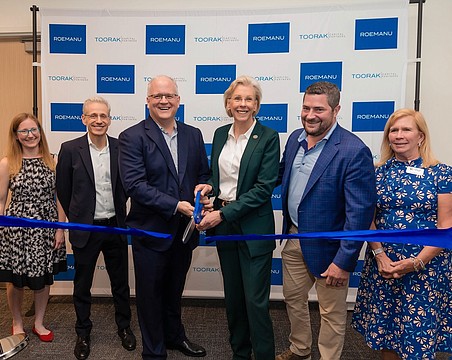'A Slow Climb'
HOME BUILDING by Janet Leiser | Senior Editor
As Hurricane Charley barreled toward Florida's Gulf Coast, general contractor Don Hughes didn't worry about possible damage to the pricey waterfront homes he was building. He could fix that.
A hurricane-ravaged housing market was another matter.
"The thing that scared me the most was you could get the houses built, but people are going to be depressed, they're not going to want waterfront anything," Hughes says. "It's going to take them a couple years to get over it and I cannot last for two years."
Hughes knows well how the exclusive home market reels after a catastrophe.
After 9/11, he had to sell, at a loss, one of the multimillion-dollar Mediterranean-style spec homes he'd built on Davis Islands, near downtown Tampa. It was the only time he lost money on one of his creations. That house sold for about $3 million. He estimates it'd sell for $5 million today.
He takes a calculated risk every time he buys a $2 million waterfront lot and razes an older, smaller house to make way for one of his extravagant, stylish houses. His niche is South Tampa, usually Davis Islands.
One of his houses recently fetched one of the highest prices ever in Hillsborough County. Hughes sold the 6,740-square-foot home at 80 Ladoga Ave., Davis Islands, to Blake J. Casper, whose family has owned Tampa-area McDonald's restaurants since the 1950s. Casper paid $5.175 million for the house that features six bedrooms and eight-and-a-half bathrooms, a wine cellar and media room, and overlooks Hillsborough Bay.
The house, finished in December, sold in March.
Working for a living
Hughes was born in Mississippi and lived in a Tampa apartment throughout his youth. His mother supported the family on a minimum-wage job. After Hughes graduated from Plant High School in 1971, he worked his way through the University of Florida where he majored in construction.
He worked for large companies in the Tampa and Orlando areas after his 1977 graduation, but didn't like it. "I was just a little cog in the wheel," he says. "I knew I was going nowhere. I was never too good at working for people."
He went to Saudi Arabia to work as a buyer for a construction company. He traveled Europe on his vacations and saved money to start his own business.
Inspired by the Mediterranean architecture he saw in his travels, he returned to Tampa in 1985 to open his company, Donald C. Hughes General Contractor Inc.
But the 31-year-old's first project was no work of art. It was a detached tool shed. "I made $800 and thought it was great," he says.
His 1985 tax return showed gross income of $8,700, Hughes says. The next year, it was $47,000.
"I didn't have any money for a long time," he says. "There were years I was going down every Friday to see how much credit I had left on my credit card. I had $60,000 in credit cards, and I was paying 20% interest to keep the materials coming."
Hughes has always built spec homes in hopes of attracting a buyer. Back then, the houses or townhouses were relatively inexpensive, he says, and he built as many as he could afford since he didn't have much borrowing power.
"It has been a slow, arduous climb," he says. "It's harder to get from zero to one than it is to get from three to 10. The hardest things were finding good workers, trades people. I was getting shafted left and right by the guys I got back then."
Subcontractors overcharged him, performed shoddy work and goofed off more than they worked. "I had a dossier, a book of who not to hire," he says. Some painters would head straight to a local pub after showing up for work.
Eventually, though, he found good workers willing to put in a hard day's work for good wages. Now he uses the same subcontractors or tradesmen, who he knows by name, on all his jobs.
"They know they're paid like clockwork, and that goes a long way," he adds. "There's a lot of loyalty built in. I hear time and time again they'll work on my jobs at our beck and call over someone else because they know exactly what they've got."
Tipping point
Hughes isn't sure exactly when it all came together for his business. He knows it wasn't the first, or even the fifth year, though.
"There was a year where we took the chance to move up in price range," he says. "It doesn't sound like much now. But we got out of where we were selling houses for $150,000 and made the plunge into $300,000."
He sold several houses in that price range pretty quickly, which brought in more revenue and the banks increased his borrowing power.
His first multimillion-dollar spec house sold in the spring of 2001. He sold it to a New Yorker, sight unseen.
The company typically builds eight houses each year. Three homes are built to customer specifications, and about five are spec homes, where he hopes to make 20% to pay his overhead. If all goes well, that's $1 million in revenue on a $5 million home.
"I will never make as much money as someone makes who sells a million widgets," Hughes says. "I can only do so many houses and make so much money. Sometimes you get several in a row that do better than usual. But it's better to make 20% on $5 million than to make 20% on $100,000."
It's costly, though, when a spec house doesn't sell soon after completion.
Hughes is now paying about 9% interest on loans he takes out to build the houses and about $8,000 annually in builders' risk insurance and flood insurance for each house.
"People always say, 'Aren't you scared of having all that product out there?' I say, 'Yeah, the only thing that scares me worse is if I had no product out there. As long as there's a spec house, there's a hope it's going to sell and I'm going to have money.
And there's no cost cutting on multimillion-dollar homes when they languish on the market, he says.
"I have to actually start spending more money to embellish it even more to be sure it does sell," Hughes says. "I'm drawing down my reserves, gambling that's what it's going to take to sell it."
But he has proven the formula works.
Frustrated artist
As soon as one house is done, Hughes is onto the next one. His typical house now takes one full year.
He's always after the next challenge.
"What's fun to me is the constant metamorphosis," Hughes says. "We live it and we're constantly trying to tweak it, make it better, do different things - just to keep it fun, keep it ahead of whatever the competition is doing."
I like doing this," he says. "It's fun for me to create stuff. I'm just a frustrated artist."
Is Hughes concerned the housing market is declining after five boom years?
Not really, he says, citing one of the well-known Florida demographic trends, that 400,000 people move to the Sunshine state every year.
As for the market's cycles, he says: "There'll be ebbs and flows, but in the end with Florida real estate, you could overpay today and still be OK in a few years."
And even if more hurricanes hit Florida, people will continue to move to the coast, he says.
"There are always people who are going to want to live on the waterfront," he says, "and they don't care what it costs."





